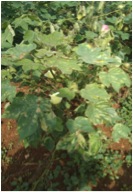Agricultural crops :: Cash crops :: Cotton
Verticillium wilt : Verticillium dahliae
Symptom
- Affects the crop in square and boll formation stages
- Bronzing of veins followed by interveinal chlorosis, yellowing and scorching of leaves
- Leaves exhibit drying of leaf margins and areas between veins shows “Tiger stripe symptom”
- Affected plants remain barren showing pinkish discoloration in stem and wood.
Survival and Mode of Spread
- Survive in the infected plant debris and in soils as microsclerotia up to 14 years. Seeds also carry microsclerotia and conidia in the fuzz.
- Primary spread through soil.
- Secondary spread through the contact of diseased roots to healthy ones and through dissemination of infected plant parts through irrigation water and other implements.
Favourable Conditions
- Low temperature of 15-200C, low lying and ill-drained soils.
- Heavy soils with alkaline condition.
- Heavy doses of nitrogenous fertilizers.
Management
- Remove and burn the infected plant debris in the soil after deep summer ploughing.
- Apply farm yard manure or other organic manures @4 t/ac.
- Follow mixed cropping with non-host plants to lower the soil temperature below 200C by providing shade.
- Follow crop rotation by growing paddy or lucerne or chrysanthemum for 2-3 years.
- Treat the acid-delinted seeds with Chlorothalonil at 4 g/kg of seed .
- Treat seeds with Bacillus subtilis (10g/kg) or Trichoderma asperellum @ 4 g/kg.
- Apply Trichoderma asperellum @ 1 kg/ acre, twice in the soil during sowing and 90 DAS . Multiply 1 kg of T. asperellum in 100 kg of Farm yard manure for 15 days before application.
Source of information
|

|

|
Tiger Stripe Symptom |
|
|


